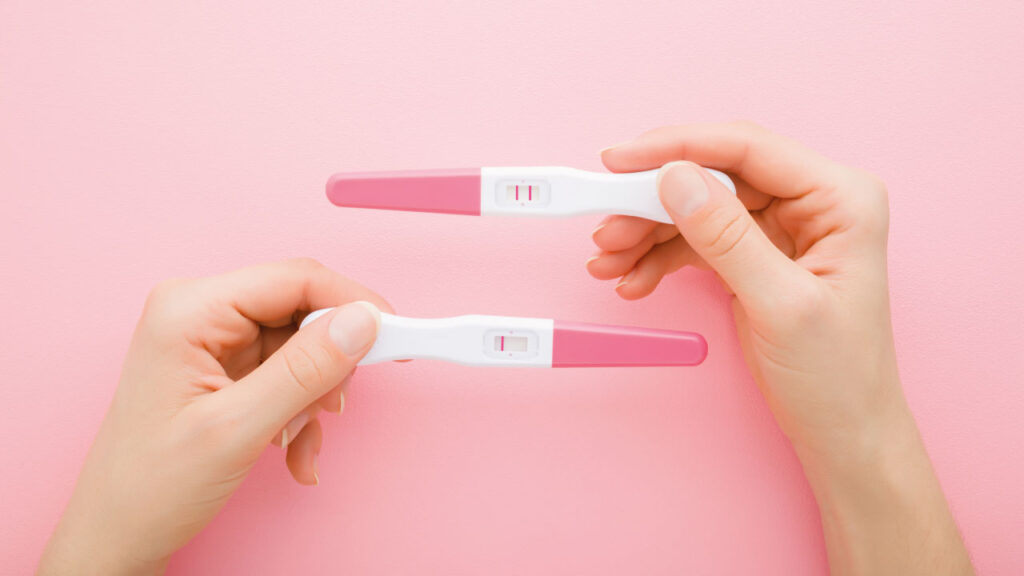Doubt knocks at the door and the heart races. Is it? It’s natural to feel anxious, with a thousand questions in your head: “Am I pregnant?” “When should I take a pregnancy test?” “How does it really work?”. How does it really work? If you’re going through this moment, take a deep breath – this article is for you.
Here, we explain everything you need to know about pregnancy tests, from how they work to the right way to take them. And because the internet is full of myths and homemade solutions, we’ll also reveal what’s true and what’s not. Are you ready? Let’s get to it!
What is a pregnancy test and how does it work?
The pregnancy test is a simple and effective way of finding out if you’re pregnant. It works by
There are two main types:
- Urine test: can be done at home with a stick bought at the pharmacy. It’s quick and easy to use
- Blood test: carried out in a laboratory, this is more sensitive and lets you know not only if you’re pregnant, but also what stage of pregnancy you’re in.
When should I take a pregnancy test?
The ideal time to take a pregnancy test is from the first day of menstrual delay. At this point, hCG levels are already high enough to be detected. However, if you don’t have regular cycles or have had unprotected sex recently, the test will only be considered definitive 19 days after the intercourse.
If you choose to take the test before your period is due, choose a more sensitive test that can be used up to 6 days before your period is due. Such as Clearblue Digital Ultra Early.
For greater reliability, do the test in the morning, with the first urine of the day, which has a higher concentration of hCG.
How do I take a pregnancy test?
Taking a pharmacy pregnancy test is simple:
1. Take the stick out of the packaging and remove the cap
2. Place the absorbent tip under the urine stream for a few seconds or dip it into a collected urine sample
3. Put the cap back on and leave the stick on a flat surface
4. Wait for the time indicated in the instructions (usually 1-3 minutes)
5. Read the result:
- Positive: two lines or the word “Pregnant” appear
- Negative: only one line appears or the word “Not pregnant”.
If the result is unclear (for example, a very faint line), repeat the test after a few days.

What is a false positive?
A false positive occurs when a pregnancy test indicates that you are pregnant, but in fact you are not. Although pharmacy tests are fairly accurate, some factors can lead to this type of result, such as:
- Use of medicines containing hCG (such as fertility treatments)
- Presence of ovarian cysts or other health conditions
- Test out of date or poorly stored
- Early pregnancy loss, as in a chemical pregnancy
If you have a positive test and have doubts about its reliability, it is always advisable to check with a doctor.
What about a false negative?
A false negative occurs when the test indicates that you are not pregnant, but you actually are. This can happen in situations such as
- Test carried out too early, before hCG levels are detectable
- Dilute urine, especially if you drank a lot of fluids before the test
- Errors in the procedure, such as not following the instructions correctly
- Low-sensitivity tests, less able to detect initial levels of hCG.
If you have symptoms of pregnancy and the test is negative, we recommend repeating it a few days later or consulting a doctor for clarification.
The myth of infallible home pregnancy tests
With so many suggestions circulating on the internet, many women may be tempted to resort to a home pregnancy test to try and get a result before taking a pharmacy test. The truth is, however, that home-made options are unreliable and have no scientific basis. Some methods, such as the home pregnancy test with saliva, vinegar, sugar or even the home pregnancy test with lemon, are just popular myths that have been circulating for generations.
These methods, often called “foolproof home pregnancy tests”, have no real power to detect the hCG hormone which, as explained above, is responsible for confirming a pregnancy. Instead, they are based on chemical reactions or popular beliefs which, at best, have no effect and, at worst, can give false or misleading results.
To guarantee an accurate and safe answer, it’s best to use pharmacy pregnancy tests, which are scientifically proven and have a high accuracy rate, more than any home pregnancy test.
The most common questions about pregnancy tests
Early signs include menstrual delay, nausea, tiredness and increased breast tenderness. Confirm with a pregnancy test.
Usually from 1-2 weeks after conception, depending on the type of test used.
From the first day of menstrual delay or 19 days after unprotected intercourse.
Follow the instructions on the packaging, placing the stick under the urine stream or dipping it into a collected sample.
Ideally, in the morning, with the first urine of the day (for greater contraction of hCG in the urine).
Prices vary between five and 20 euros, depending on the brand and the functionalities of the test.
In pharmacies, supermarkets or online.




